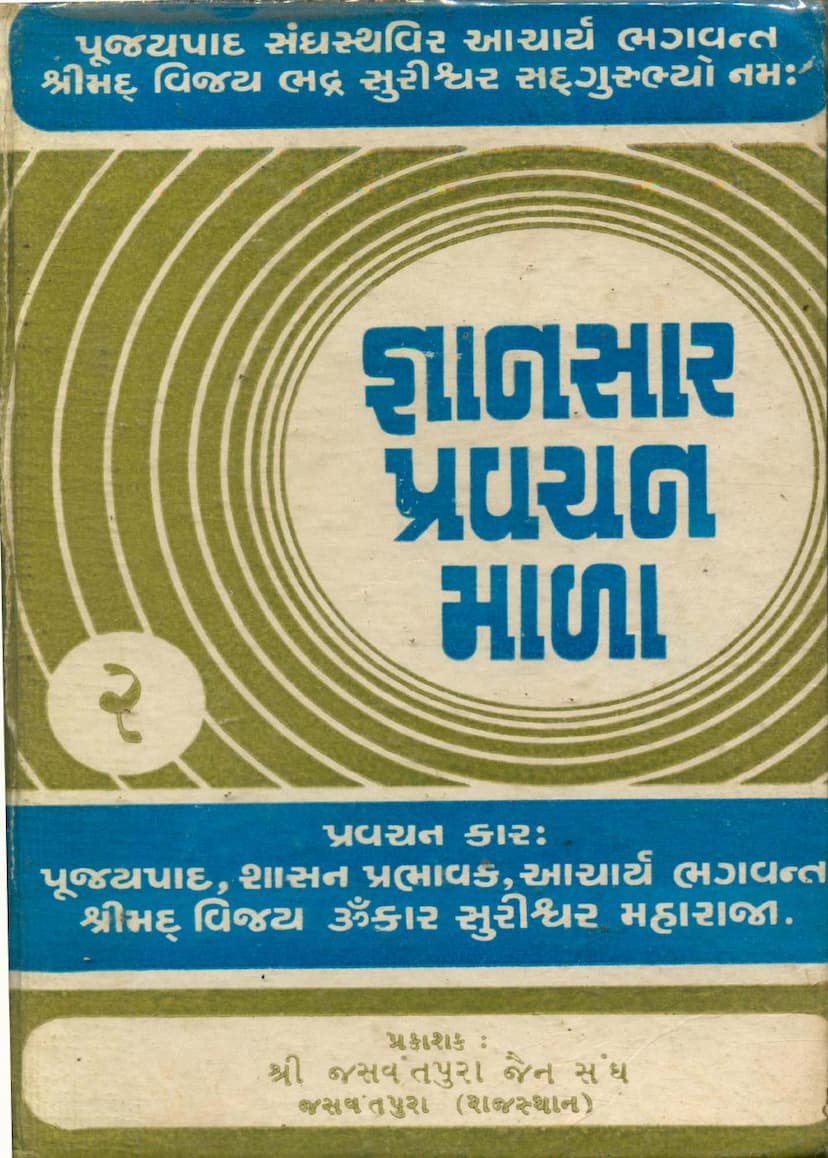Gyansara Pravachanmala Part 02
Added to library: September 1, 2025

Summary
Here is a comprehensive summary of "Gyansara Pravachanmala Part 02" by Vijayomkarsuri, based on the provided text:
Book Title: Gyansara Pravachanmala Part 02 Author: Pujyaapad, Shasanprabhavak, Acharya Bhagwan Shri Mad Vijay Omkar Surishwarji Maharaj Publisher: Shri Jaswantpura Shvetambar Moortipujak Jain Sangh, Jaswantpura (Rajasthan) Content Focus: The book is a collection of discourses (pravachans) by Acharya Vijay Omkar Surishwarji Maharaj on the 3rd and 4th sections (ashtak) of the renowned "Gyansara Granth" by Mahamahopadhyaya Shri Yash Vijay Maharaj.
Core Theme: The central theme of these discourses revolves around achieving stability of mind (chitt-sthirta) and steadfastness in spiritual practice (aaradhakta) to attain true happiness and liberation. The book guides readers on a journey from the realm of words to the realm of inner experience and emotion.
Key Concepts and Topics Explored:
-
The Nature of True Pursuit:
- "What you seek is within you": The discourses begin by questioning humanity's constant outward striving for happiness and possessions, emphasizing that the true source of bliss is within the self.
- The Futility of External Searching: Like searching for a ring in a pond while it's already on your finger, people often chase external pleasures, overlooking the inner treasure of peace and contentment.
- The Illusion of Material Possessions: The book highlights that material wealth, status, and fleeting pleasures do not bring lasting happiness. The constant pursuit of these leads to dissatisfaction and "no time" for spiritual growth.
-
The Importance of Stability and Steadfastness:
- Mind as a Source of Stability or Instability: The mind, if uncontrolled, is the root of all suffering. Through practices like penance, self-study, and meditation, one can achieve mental stability.
- The Impact of External Stimuli: The discourses discuss how external factors, be it pleasant or unpleasant, can easily destabilize the mind if one is not internally grounded.
- The Role of Faith and Devotion: True devotion and faith in the teachings of the Tirthankaras and the guidance of Gurudev are presented as crucial for developing inner strength and stability.
- "Action's Medicine: The Disease of Samsara": The book suggests that righteous actions and adherence to principles are the remedies for the afflictions of worldly existence.
-
Practical Guidance for Spiritual Growth:
- Mindful Living: The importance of mindfulness, awareness (jagruti), and diligence (apramad) in daily life is stressed. Even simple actions, when performed with awareness, can become spiritual practices.
- The Power of Routine and Discipline: The discourses advocate for a disciplined routine, including regular study of scriptures (Jinavani), meditation, and righteous conduct.
- Overcoming Obstacles: Various analogies are used to illustrate how to overcome mental distractions, desires, and attachments. The example of Ilaichikumar is used to differentiate between true renunciation and conditional giving.
- The Significance of Inner Qualities: The book emphasizes qualities like detachment, humility, contentment, compassion, and equanimity as essential for spiritual progress.
- The True Meaning of Wealth and Success: True wealth is not material possessions but spiritual attainment, inner peace, and the realization of the true self.
- The Transformative Power of Gurudev's Teachings: The discourses consistently refer to the profound impact of the teachings of the Gurudevs, highlighting their ability to guide and uplift followers.
-
Illustrative Stories and Examples:
- The book draws extensively from Jain lore, historical anecdotes, and philosophical parables to illustrate its points. Stories of Ilaichikumar, Nayasar, Vajraswami Maharaj, Anjana sati, Chaumraj Wala's mother, Meghkumar, and others are used to explain complex spiritual concepts.
- The narrative of Ilaichikumar's encounter with the muni and the dancer highlights the illusory nature of worldly attachments and the power of true renunciation.
- The story of the minister building a temple illustrates the difference between outward devotion and true inner devotion.
- The example of the beggar's son, found by his parents, serves as an analogy for the self being unaware of its own innate bliss.
-
Specific Practices and Principles:
- Chaitanya Shikshashtaka: The text refers to verses that express longing for spiritual union and deep devotion.
- Pratikraman and Samayika: These daily spiritual practices are presented as vital for self-purification and mental discipline.
- Austerities (Tapas): The importance of various forms of austerity is discussed as a means to control desires and burn karmas.
- The Eight Auspicious Signs (Ashta Pratīhārya): These are described as symbols of the soul's inherent purity and divine nature.
- Proper Diet and Lifestyle: Emphasis is placed on balanced eating, moderate lifestyle, and avoiding excessive indulgence, which are seen as conducive to spiritual practice.
- The Significance of Gurubhakti: Devotion and surrender to the Guru are highlighted as essential for spiritual guidance and progress.
Overall Message:
"Gyansara Pravachanmala Part 02" is a profound and practical guide that aims to help individuals understand the ephemeral nature of worldly pleasures and the enduring bliss that lies within the self. Through a rich tapestry of stories, philosophical insights, and practical advice, Acharya Vijay Omkar Surishwarji Maharaj inspires readers to cultivate inner stability, control their minds, and embark on a journey of self-realization, ultimately leading to liberation (moksha). The discourses encourage a shift from outward performance to inward experience, fostering a deeper connection with the spiritual path.